Transfer Letter From One Company To Another
[Your Name]
[Your Address]
[City, State, Zip Code]
[Date]
[Recipient's Name]
[Recipient's Title]
[New Company Name]
[New Company Address]
[City, State, Zip Code]
Dear [Recipient's Name],
I hope this letter finds you well. I am writing to formally request a transfer from my current position at [Current Company Name] to a comparable position at [New Company Name]. After careful consideration, I believe that this move aligns with my career goals and offers me new opportunities for growth and development.
I have thoroughly enjoyed my time at [Current Company Name] and am grateful for the experiences and skills I have gained during my tenure here. However, the chance to contribute to the team at [New Company Name] while continuing to challenge myself professionally is an opportunity I am eager to explore.
I understand that a transfer involves a comprehensive evaluation process and am prepared to provide any information or documentation necessary to facilitate a smooth transition. I am confident that my experience in [current role] and my commitment to excellence make me a suitable candidate for this transfer.
I kindly request your assistance in initiating the transfer process and guiding me through any required steps. Please let me know if there are specific forms or documents that need to be completed, or if there is any additional information you require from my end.
I would appreciate the opportunity to discuss this transfer request in person at your earliest convenience. I am available at [your phone number] or [your email address]. Thank you for considering my request, and I look forward to the potential of contributing to the success of [New Company Name].
Sincerely,
[Your Name]
[Your Employee ID]
[Your Current Department]
[Your Contact Information: Phone Number and Email Address]
Official Transfer Letter from One Company to Another
Subject: Transfer of Employee
Dear [Employee Name],
We are pleased to inform you that you have been officially transferred from [Current Company] to [New Company] effective [Date]. This decision comes as part of our strategic collaboration and your exemplary performance.
Please report to [New Supervisor/Department] at [New Company Address] on your first day. Your roles, responsibilities, and compensation will remain consistent with your current arrangement unless otherwise communicated.
We wish you success in your new assignment.
Sincerely,
[Sender Name]
[Position]
[Current Company]
Provisional Transfer Email
Subject: Provisional Notification of Transfer
Hi [Employee Name],
This email serves as a provisional notice regarding your transfer from [Current Company] to [New Company]. The final confirmation and details will follow once all internal approvals are completed.
Kindly prepare your documents and coordinate with HR for a smooth transition. Do not hesitate to reach out if you have questions.
Best regards,
[Sender Name]
HR Department
Casual Internal Transfer Message
Hey [Employee Name],
Good news! You're moving over to our partner company, [New Company], starting [Date]. Everyone’s excited to have you join the team there.
Make sure you sync with your new manager, [Manager Name], for your onboarding. We'll miss you around here but can't wait to see the great work you’ll do!
Cheers,
[Sender Name]
Heartfelt Transfer Letter
Subject: Wishing You Success in Your New Role
Dear [Employee Name],
It has been a pleasure having you on our team. As you transition from [Current Company] to [New Company], we want to express our sincere gratitude for your contributions.
We are confident that you will continue to thrive and make a positive impact. Wishing you all the success and happiness in your new journey.
Warm regards,
[Sender Name]
[Position]
Quick Transfer Notification Email
Subject: Transfer Update
Dear [Employee Name],
You will be transferred to [New Company] effective [Date]. Please follow up with HR for further instructions.
Thank you,
[Sender Name]
What / Why of a Transfer Letter
What is a Transfer Letter and Why It Is Needed
- A transfer letter formally notifies an employee about their move from one company to another or between departments.
- It serves as an official record of employment changes and helps manage expectations.
- It ensures clarity regarding reporting, roles, responsibilities, and effective dates.
- It can also convey goodwill, provide guidance, and maintain professional decorum.
Who Should Send a Transfer Letter
Who Sends a Transfer Letter
- Usually sent by HR departments or direct supervisors.
- Can also be issued by company management or corporate communications teams.
- For provisional or casual notifications, a team lead or project manager may send the message.
Whom the Transfer Letter Should Be Addressed To
Recipient of a Transfer Letter
- The employee being transferred.
- In some cases, CC the new department manager or HR at the receiving company.
- For official documentation, higher management may be included.
When to Send a Transfer Letter
Timing and Scenarios for Sending a Transfer Letter
- When an employee is moving from one company to another under an agreement or acquisition.
- Internal promotions requiring relocation to a different branch or department.
- Project-specific transfers requiring specialized skills elsewhere.
- After approvals and before the effective date to allow preparation.
How to Write and Send a Transfer Letter
Writing and Sending Process
- Determine the type of transfer: official, provisional, casual, or heartfelt.
- Decide the tone based on company culture and employee relationship.
- Include key details: effective date, reporting location, supervisor, and responsibilities.
- Proofread for clarity and professionalism.
- Send via email for quick acknowledgment or printed letter for formal documentation.
Requirements and Prerequisites
Preparations Before Sending a Transfer Letter
- Confirm approval from all relevant departments.
- Gather employee details: role, tenure, current performance, and responsibilities.
- Prepare documentation for both sending and receiving companies.
- Communicate internally to ensure the employee’s smooth transition.
Formatting Guidelines for Transfer Letters
Formatting a Transfer Letter
- Keep it concise: ideally 150–250 words for official letters.
- Tone should match purpose: formal, casual, heartfelt, or quick notification.
- Use clear subject lines in emails: “Transfer Notification: [Employee Name]”.
- Include a polite greeting, clear instructions, and cordial closing.
- Attach relevant documents if needed: HR forms, relocation guidelines, or role descriptions.
Tricks and Tips for Transfer Letters
Tips for Effective Transfer Letters
- Use templates to ensure consistency across the organization.
- Customize tone based on employee relationship.
- For digital notifications, confirm receipt via reply.
- Include transition support information to reduce employee anxiety.
- Avoid ambiguous language that could cause confusion.
Common Mistakes to Avoid
Mistakes in Transfer Letters
- Sending the letter before approvals are finalized.
- Providing incomplete information about reporting or responsibilities.
- Using inappropriate tone: too casual for formal situations or too rigid for casual transfers.
- Neglecting to follow up to confirm acknowledgment.
Elements and Structure of a Transfer Letter
Essential Components
- Subject/Title: Clearly state it is a transfer notification.
- Greeting: Address the employee directly.
- Main Content: State the transfer, effective date, location, and role.
- Instructions: Include steps for onboarding or reporting.
- Closing: Polite conclusion with sender details.
- Attachments (Optional): HR forms, role descriptions, relocation info.
After Sending / Follow-Up Actions
Post-Sending Considerations
- Confirm the employee received the letter/email.
- Ensure HR updates all relevant records and systems.
- Coordinate with the receiving company for onboarding or orientation.
- Provide support for questions or concerns about the transfer.
Does a Transfer Letter Require Attestation?
Attestation and Authorization
- Official company-to-company transfers often require signatures from HR and management.
- In certain legal or inter-company agreements, notarization may be required.
- Provisional or internal transfer notifications may not require formal attestation.
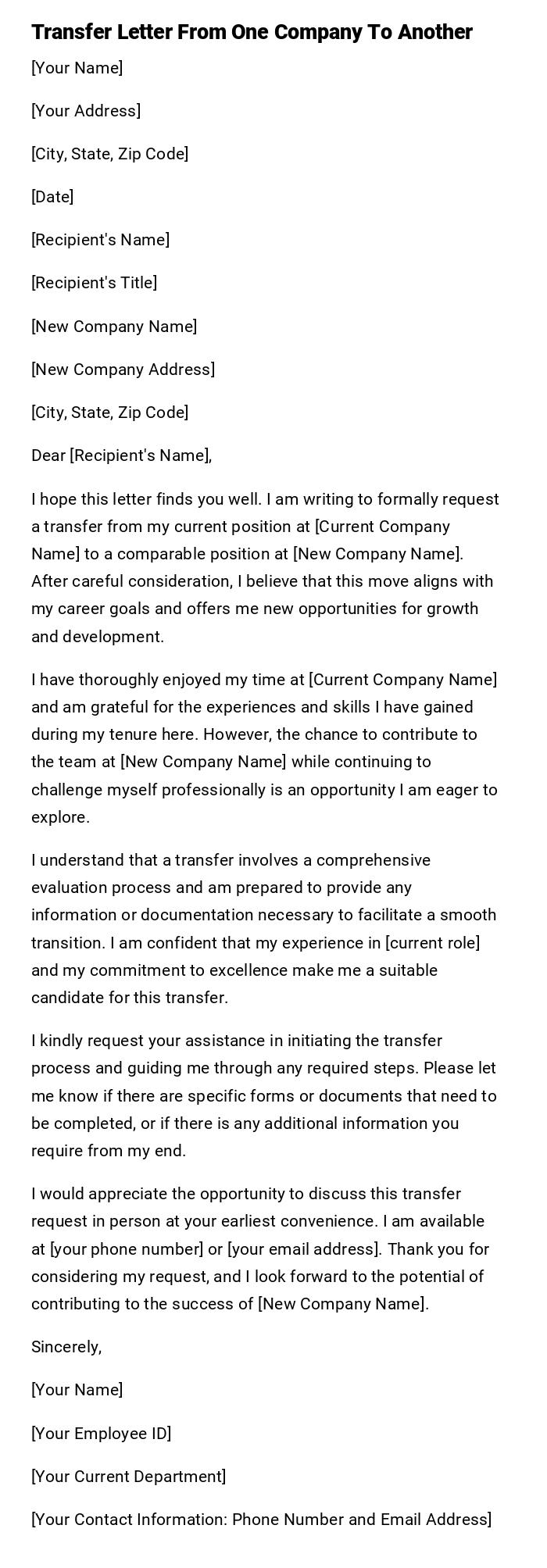
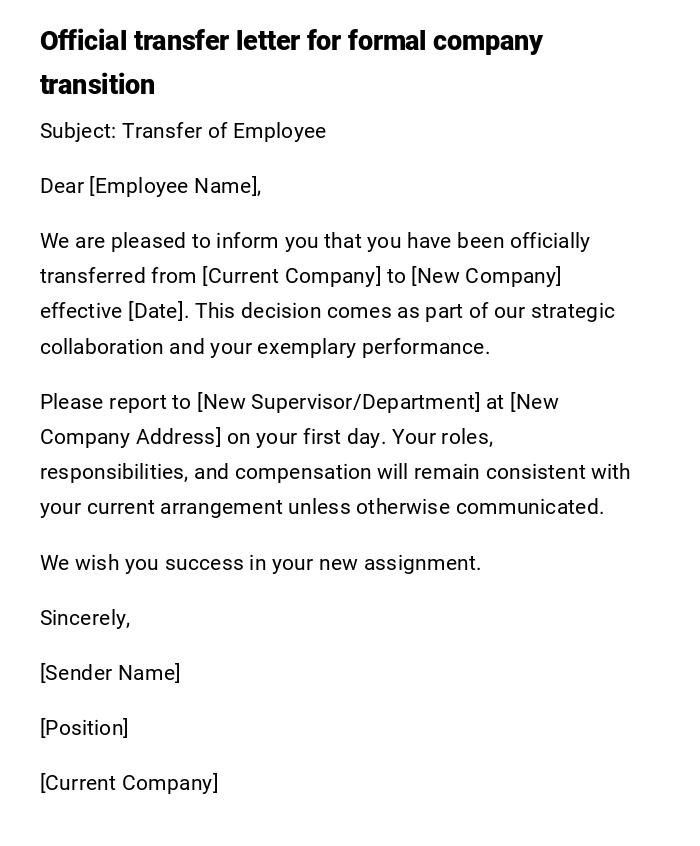
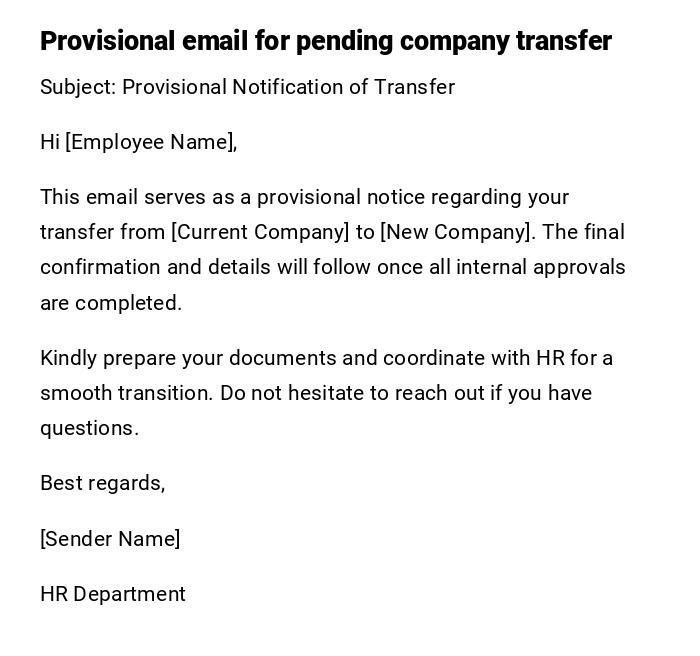
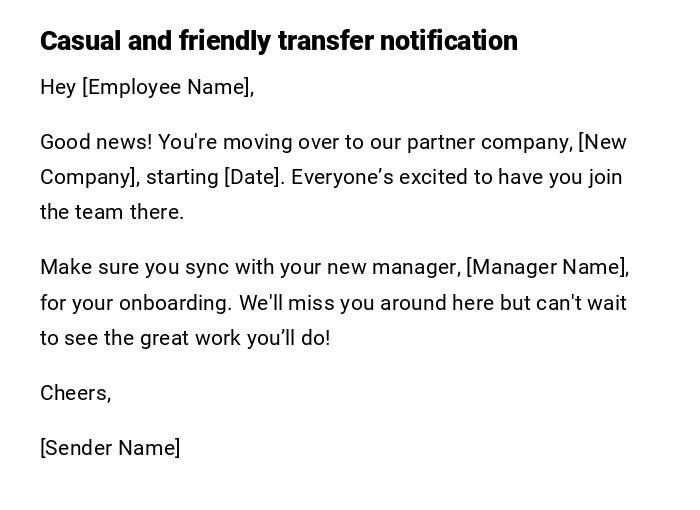
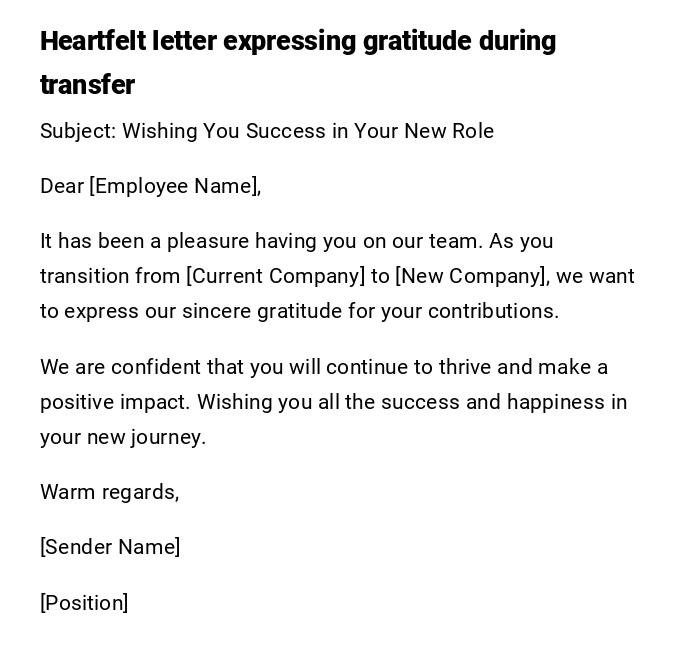
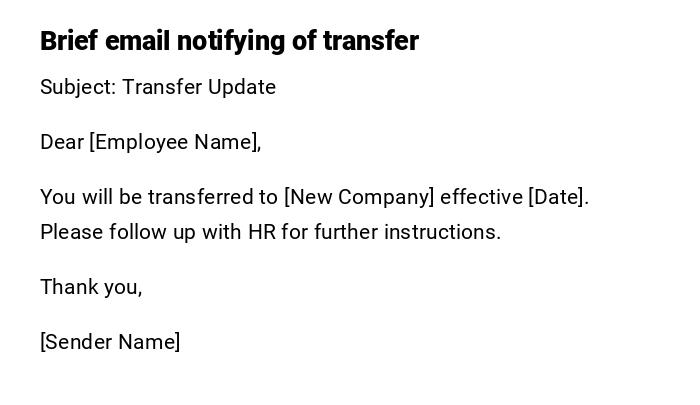

 Download Word Doc
Download Word Doc
 Download PDF
Download PDF